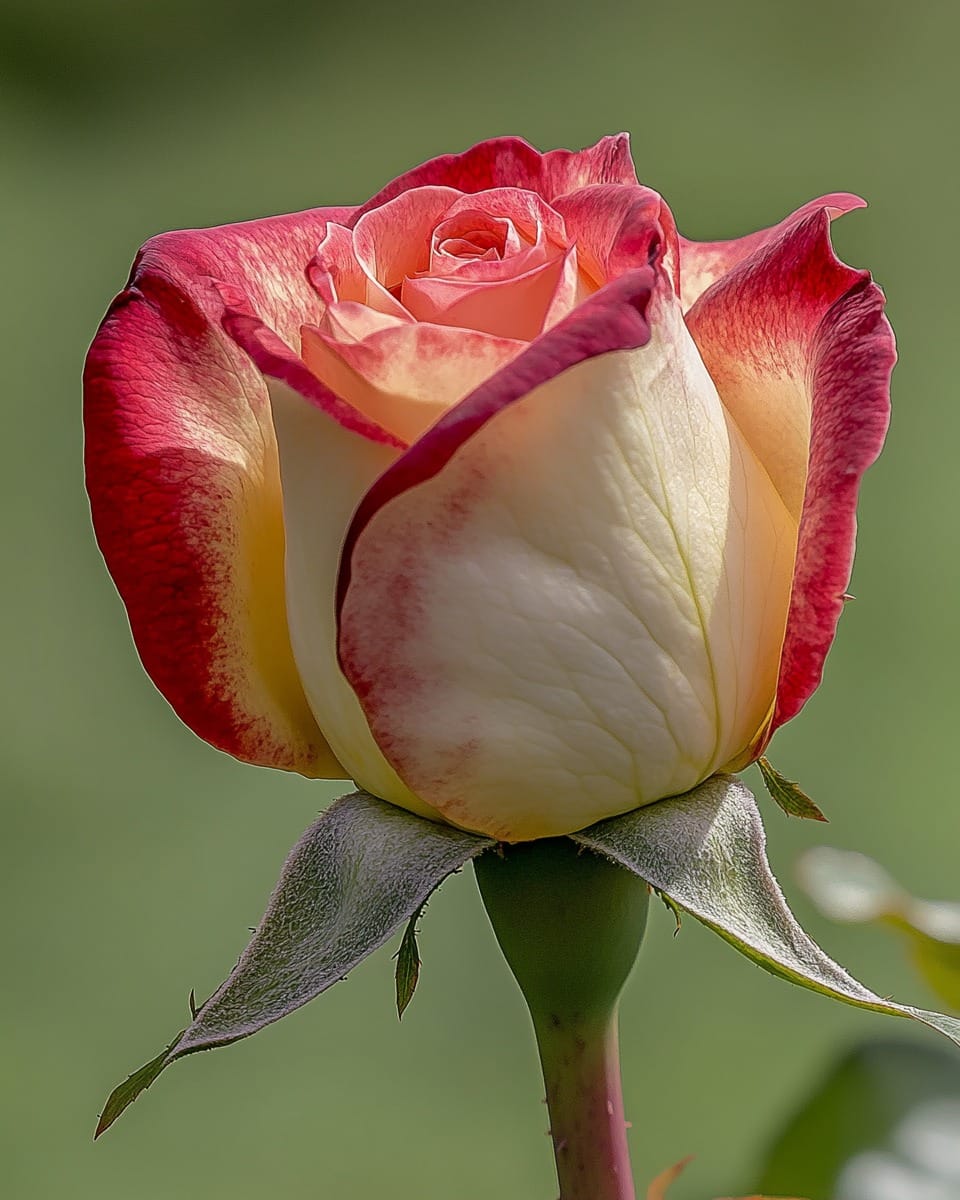The Osiria Rose is one of the most captivating and unique rose varieties, renowned for its dramatic bicolor petals. The stunning contrast between deep red outer edges and creamy white centers makes this rose a standout in any garden or floral arrangement. Its elegant, romantic appearance has earned it a special place in both landscaping designs and bouquets, where it adds a touch of sophistication and beauty. Perfect for gardeners looking to create a romantic garden or showcase a striking flower, the Osiria Rose never fails to impress.
Light Requirements:
The Osiria Rose thrives in full sun. Roses, in general, require at least 6 hours of direct sunlight per day to grow and bloom well, and the Osiria Rose is no different. Providing your rose with plenty of sunlight helps it grow strong and promotes vibrant, healthy blooms. Full sun also enhances the vivid color contrast of the red and white petals, intensifying the beauty of this stunning flower. Make sure to plant the Osiria Rose in a location that receives ample sunlight throughout the day for optimal growth and flowering.
Watering Needs:
Watering the Osiria Rose deeply and consistently is essential for its health and beauty. Roses need evenly moist soil to grow well, but they do not like soggy conditions. Water deeply at the base of the plant, ensuring that the roots are adequately hydrated, but allow the soil to drain well to prevent water from pooling around the roots. Check the soil regularly, and water when the top inch feels dry. Be cautious not to wet the foliage, as this can promote fungal diseases. A good watering routine will ensure healthy growth and the development of abundant, vibrant blooms.
Soil Preferences:
The Osiria Rose prefers well-draining, fertile soil. Roses generally thrive in loamy, slightly acidic soil with a pH level between 6.0 and 6.5. Well-draining soil is essential to prevent root rot and other issues that arise from waterlogged conditions. To improve drainage, you can amend heavy or clayey soil with organic matter such as compost. A fertile soil will provide the necessary nutrients for the plant to grow strong and produce beautiful flowers. You can also add mulch around the base of the rose to retain moisture, suppress weeds, and regulate soil temperature.
Temperature Tolerance:
The Osiria Rose thrives in temperate climates, where temperatures are moderate, and seasonal changes are distinct. It prefers temperatures between 60°F and 75°F (15°C to 24°C). Although it can tolerate cooler temperatures, it is best suited for regions that don’t experience extreme cold or intense heat. In colder climates, consider planting the rose in a protected area, or you may need to bring it indoors during the winter. Conversely, in warmer climates, protect the rose from extreme heat by ensuring it has adequate water and some afternoon shade. Proper care ensures that the Osiria Rose remains healthy and vibrant throughout the growing season.
Fertilization:
For optimal growth and to promote vibrant blooming, the Osiria Rose benefits from rose-specific fertilizer. Apply a balanced, slow-release fertilizer every 4-6 weeks during the growing season, typically from spring through late summer. A fertilizer designed for roses will provide the necessary nutrients to support strong root development, lush foliage, and abundant flowers. It’s important not to over-fertilize, as this can lead to excessive leaf growth at the expense of flowers. Follow the instructions on the fertilizer packaging for best results.
Planting Tips:
To plant the Osiria Rose, choose a sunny location with well-draining soil. Dig a hole that is about twice the size of the root ball and ensure the base of the plant is level with the soil surface. If you’re planting multiple roses, space them about 18-24 inches apart to allow for proper air circulation and to prevent overcrowding. After planting, water thoroughly to help settle the soil around the roots. Mulch the base with a layer of organic material to help maintain moisture and reduce the growth of weeds.
Design Tips:
The Osiria Rose is a perfect choice for creating a romantic garden design. Its striking bicolor petals make it ideal for planting in border beds, flower gardens, or rose gardens. You can pair it with other romantic flowers such as lavender, white daisies, or peonies for a harmonious color palette. The Osiria Rose also works beautifully as a cut flower in floral arrangements, where it can be used in bouquets, centerpieces, or wedding flowers. Its elegant color combination adds a sophisticated touch to any floral display, making it a popular choice for special occasions and celebrations.
Conclusion:
The Osiria Rose is a truly stunning and unique variety that brings a touch of romance and elegance to any garden or floral arrangement. Its dramatic bicolor petals with rich red and white hues make it a standout flower that will capture attention wherever it’s planted. By following the care guidelines for full sun, well-draining soil, and consistent watering, you’ll be rewarded with abundant blooms and vibrant colors that will brighten up your space. Whether as part of a romantic garden design or in a bouquet, the Osiria Rose is sure to leave a lasting impression. 🌹
More Articles You Might Like
-
Texas Toast Sloppy Joes: The Crunchy, Cheesy Upgrade You Didn’t Know You Needed
There’s something timeless about sloppy joes. For generations, this saucy, savory, and slightly sweet ground beef sandwich has been a go-to comfort food in American kitchens. It’s quick, filling, and family-friendly—perfect for busy weeknights. But what if we told you there’s a way to take this classic dish up a notch? Enter the Texas Toast…
-
Classic Pig Pickin’ Cake
When it comes to Southern desserts, few sweets shine as brightly as the Classic Pig Pickin’ Cake. This nostalgic cake, sometimes called a “Mandarin Orange Cake,” has roots deep in Southern tradition. It gets its playful name from its frequent appearance at pig pickin’s—Southern-style barbecue gatherings where communities come together to enjoy slow-cooked pork, sides,…
-
Lemon Garlic Butter Chicken with Creamy Parmesan Pasta
There’s something irresistible about the combination of tender, golden-browned chicken paired with a creamy pasta coated in Parmesan cheese. Add the brightness of lemon, the depth of garlic, and the richness of butter, and you have a recipe that feels indulgent yet approachable enough for a weeknight dinner. Lemon Garlic Butter Chicken with Creamy Parmesan…



